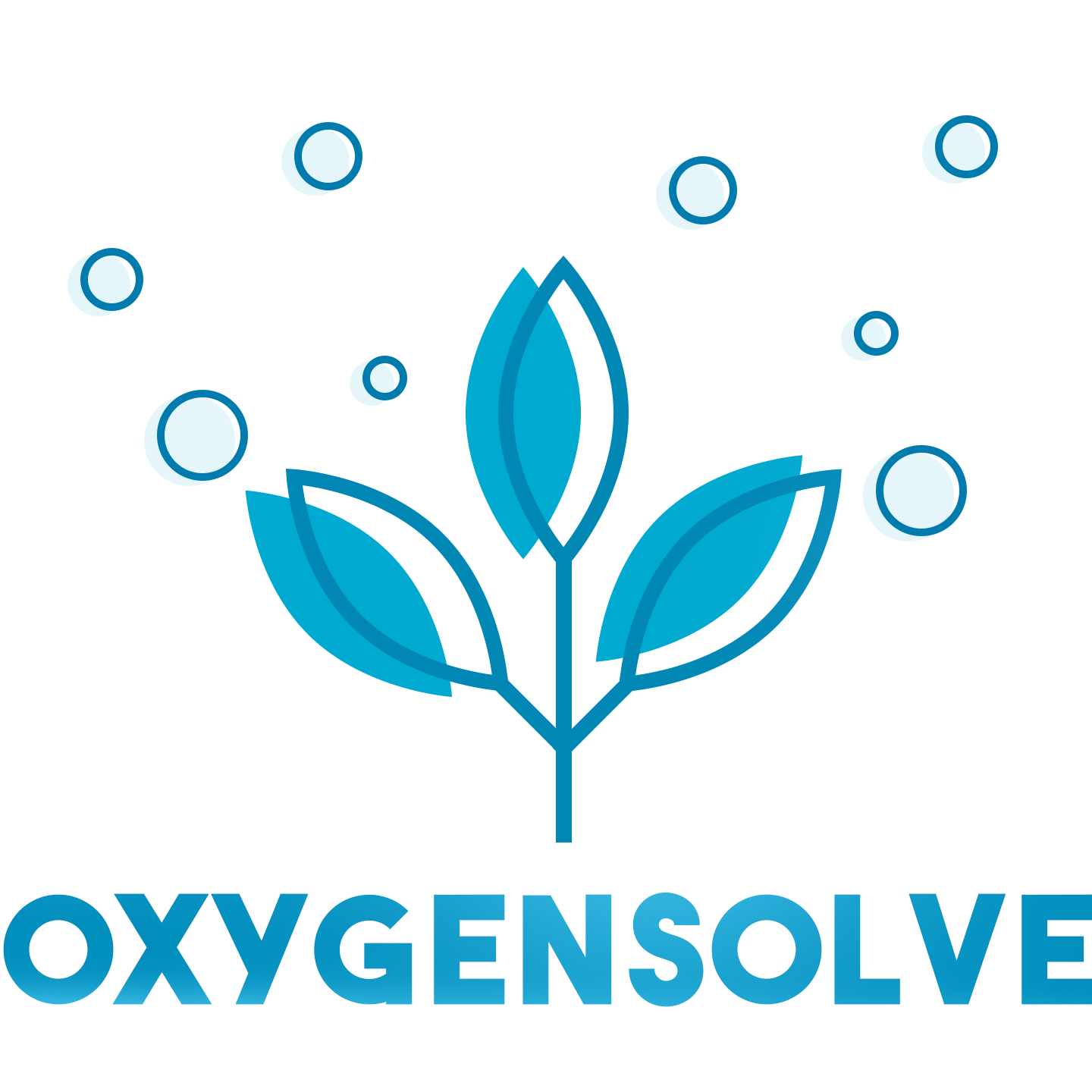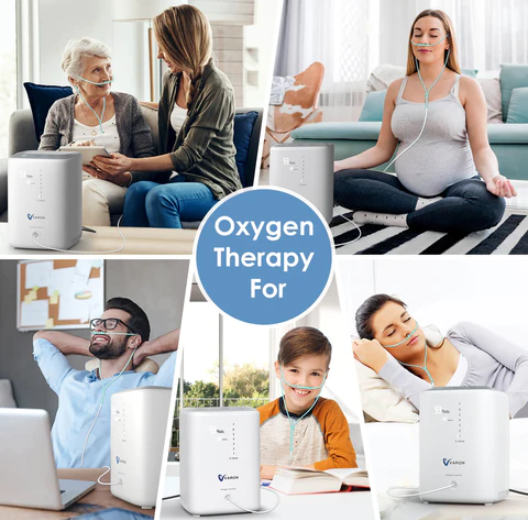Benefits of Home Oxygen Concentrator for Sleep: A Solution for Better Sleep & Breathing
CODE
Do you struggle with breathing difficulties that disrupt your sleep? You're not alone. Millions of people experience conditions like COPD, sleep apnea, and other respiratory issues that can make getting a good night's rest a challenge. Fortunately, sleeping oxygen therapy with a home oxygen concentrator for sleep can be a life-changing solution.
This guide will explore the benefits of sleeping oxygen therapy, how home oxygen concentrators for sleep work, and introduce the Oxygensolve NT-04, a powerful and user-friendly option for home oxygen concentrator for sleep!
What conditions might require sleeping oxygen therapy?
Several health conditions can cause dips in blood oxygen levels during sleep, making sleeping oxygen therapy a potential benefit. Here are some of the most common:
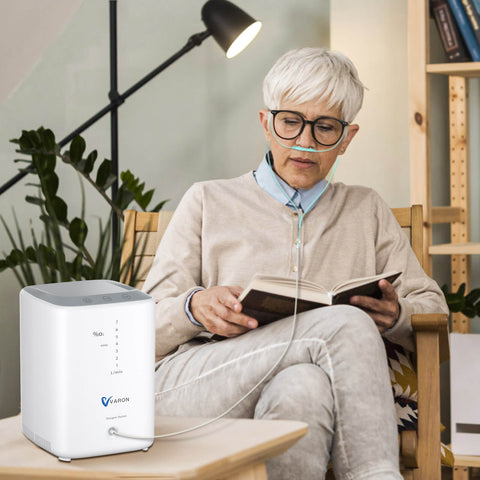
- Chronic Obstructive Pulmonary Disease (COPD): This progressive lung disease makes it difficult to breathe due to airway blockage and inflammation. It often causes shortness of breath, wheezing, and chest tightness, which can worsen during sleep.
- Sleep Apnea: This condition involves repeated pauses in breathing during sleep. When breathing stops, oxygen levels drop, leading to fragmented sleep, daytime fatigue, and increased health risks.
- Pulmonary Fibrosis: Scarring of lung tissue from various causes makes breathing difficult and reduces oxygen transfer to the bloodstream. This can lead to low blood oxygen levels during sleep.
- Congestive Heart Failure: A weakened heart struggles to pump blood effectively, leading to fluid buildup in the lungs (pulmonary edema). This fluid accumulation further restricts oxygen exchange, causing low oxygen levels during sleep.
- Other Lung Diseases: Several other lung conditions, such as cystic fibrosis, emphysema, and bronchiectasis, can also impair oxygen exchange and benefit from sleeping oxygen therapy.
How do I know if I need sleeping oxygen therapy?
You won't be able to diagnose the need for sleeping oxygen therapy on your own. However, some symptoms can indicate a potential oxygen deficiency during sleep. If you experience any of the following, consult your doctor:
- Shortness of breath, especially while lying down or during sleep
- Waking up gasping for air or feeling like you're choking
- Excessive daytime fatigue and sleepiness
- Frequent sleep disturbances and restless sleep
- Morning headaches
- Difficulty concentrating or memory problems
Your doctor will likely recommend a sleep study to assess your oxygen levels during sleep. This painless overnight test measures your blood oxygen levels and breathing patterns to determine if they fall below a healthy range. Based on the results, your doctor will decide if sleeping oxygen therapy is right for you.
Benefits of Sleeping Oxygen Therapy
Sleeping oxygen therapy with a home oxygen concentrator for sleep offers a range of benefits for individuals with low blood oxygen levels during sleep:
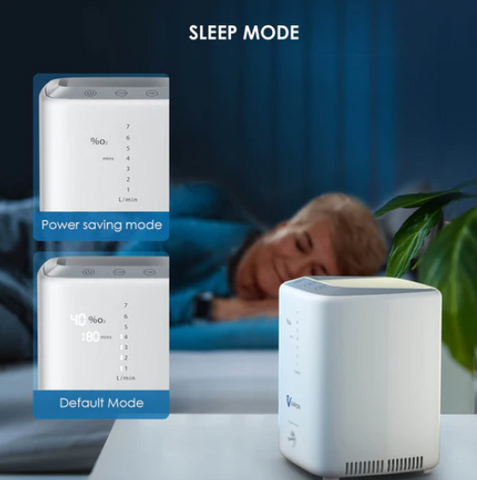
- Improved Sleep Quality: Increased oxygen levels throughout the night promote deeper, more restful sleep. This reduces sleep disturbances and allows for better overall sleep quality.
- Increased Energy Levels: With proper oxygenation, your body functions more efficiently, leading to increased energy levels during the day. You may feel less tired and more capable of tackling your daily activities.
- Enhanced Cognitive Function and Focus: Adequate oxygen supply improves brain function, leading to sharper focus, improved concentration, and better cognitive performance.
- Reduced Risk of Complications: Low blood oxygen levels can contribute to various health problems. Sleeping oxygen therapy can help reduce the risk of complications associated with conditions like heart failure, pulmonary hypertension, and cor pulmonale (heart problems caused by lung disease).
By addressing low blood oxygen levels during sleep, sleeping oxygen therapy can significantly improve your overall health and quality of life.
How Home Oxygen Concentrators Work for Sleep
Home oxygen concentrators are lifesavers for people who experience dips in blood oxygen levels during sleep. Here's a breakdown of how they work:
-
Air Intake: The home oxygen concentrator for sleep draws in room air through a filter. This air is a mixture of various gases, including about 20% oxygen and 80% nitrogen.
-
Oxygen Separation: The magic happens within a component called a zeolite sieve bed. This bed contains a special material that acts like a molecular sieve. It allows oxygen molecules (smaller) to pass through more easily than nitrogen molecules (larger), effectively separating the oxygen from the other gases in the air.
-
Pressure Swing Adsorption (PSA): The home oxygen concentrator for sleep uses a process called Pressure Swing Adsorption (PSA) to continuously regenerate the zeolite sieve bed. This involves alternating pressure within the bed. At higher pressure, oxygen is absorbed by the sieve bed, while lower pressure allows the bed to release the captured oxygen.
-
Oxygen Enrichment: The concentrated oxygen, now with a much higher percentage (typically around 90-95%) compared to room air, is collected in a storage tank.
-
Delivery System: The enriched oxygen is then delivered to the user through a nasal cannula. This consists of two thin tubes that fit comfortably into the nostrils. The flow rate of oxygen is adjustable based on your doctor's prescription.
-
Humidification (Optional): Some home oxygen concentrator for sleep have a built-in humidifier. This adds moisture to the oxygen before it reaches your nose, preventing dryness and irritation in the nasal passages, especially during long-term use.
The Oxygensolve NT-04 Home Oxygen Concentrator: Designed for Comfort and Convenience
Best Selling🔥1-7L Home Oxygen Concentrator NT-04
The Oxygensolve NT-04 is a top-rated home oxygen concentrator for sleep. Here's why it might be the perfect fit for you:
- Smarter & Lighter: Compact design and sleek lines make it unobtrusive in your bedroom.
- Dual Functionality: Provides continuous oxygen flow (1-7 L/min) and nebulizer therapy for added respiratory support.
- Pure & Clean Oxygen: Multi-stage filtration ensures you receive clean, humidified oxygen for comfortable breathing.
- Sleep Mode: Dims the display for a more peaceful sleep environment.
- Easy to Use: Large buttons, remote control, and automatic features make it user-friendly for all ages.
- Safety Features: One-click SOS button provides peace of mind for you and your loved ones.
Safety of Using a Home Oxygen Concentrator While Sleeping
Home oxygen concentrators for sleep are safe for use when following the manufacturer's instructions and safety precautions. Here are some key points to remember:
- Oxygen is Flammable: Since oxygen supports combustion, avoid smoking or using open flames near the concentrator.
- Maintain a Safe Distance: Keep the oxygen concentrator for sleep at least a few feet away from heat sources like radiators or fireplaces.
- No Flammable Materials: Don't store flammable liquids, cleaning products, or petroleum-based ointments near the oxygen concentrator.
- Electrical Safety: Regularly inspect the power cord for any damage and avoid overloading electrical outlets.
- Alarms and Alerts: Be familiar with the oxygen concentrator's alarm system. These alerts might indicate low oxygen levels, power outages, or malfunctions.
Cleaning and Maintaining Your Home Oxygen Concentrator
Regular cleaning and maintenance are crucial for optimal performance and safety of your home oxygen concentrator for sleep. Here's a basic routine to follow:
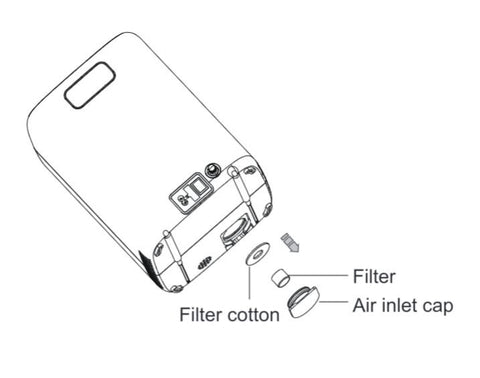
- Filter Cleaning: Refer to the manufacturer's instructions for the recommended cleaning frequency for the air intake filter. This usually involves washing or replacing the filter at specific intervals.
- Humidifier Maintenance (if applicable): Clean the humidifier chamber and replace the water regularly according to the manufacturer's guidelines. This helps prevent the growth of bacteria or mold.
- Cannula Cleaning: Wash the nasal cannula with mild soap and warm water daily. Allow it to dry completely before reuse.
- Wiping Down the Unit: Wipe the exterior of the concentrator with a damp cloth to remove dust and debris. Avoid using harsh chemicals or abrasive cleaners.
- Regular Inspections: Schedule regular professional inspections of your home oxygen concentrator as recommended by the manufacturer or your healthcare provider.
Remember, this information is for general knowledge and should not replace the specific instructions provided by your healthcare professional or the user manual of your home oxygen concentrator for sleep.
Conclusion: Breathe Easier, Sleep Sounder with Home Oxygen Therapy
If you struggle with sleep due to breathing difficulties, sleeping oxygen therapy can be a life-changing solution. By providing a steady stream of enriched oxygen throughout the night, it can significantly improve your sleep quality, boost your energy levels, enhance cognitive function, and reduce the risk of complications associated with low blood oxygen.
Oxygensolve offers a variety of top-rated home oxygen concentrators, like the NT-04, designed for comfort, convenience, and optimal performance during sleep. With features like quiet operation, automatic functions, and user-friendly controls, our concentrators can help you breathe easier and sleep better.
Don't wait to experience the benefits of a good night's sleep! Visit our website or contact us today to learn more about Oxygensolve home oxygen concentrators for sleep and how they can help you breathe easier and live a healthier life.




